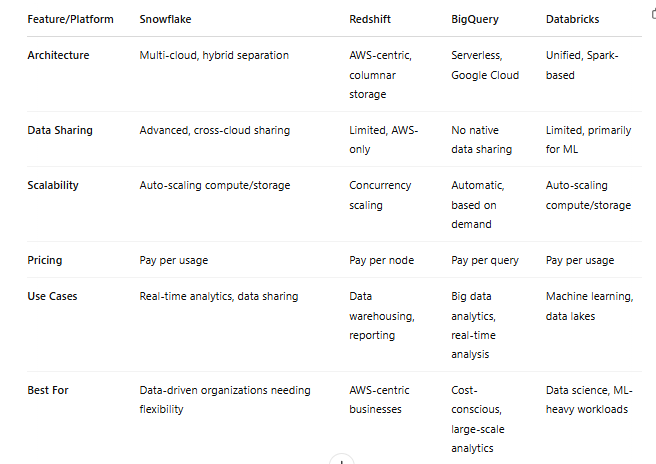Snowflake vs Redshift vs BigQuery vs Databricks: A Detailed Comparison

In the world of cloud-based data warehousing and analytics, organizations are increasingly relying on advanced platforms to manage their massive datasets. Four of the most popular options available today are Snowflake, Amazon Redshift, Google BigQuery, and Databricks. Each offers unique features, benefits, and challenges for different types of organizations, depending on their size, industry, and data needs. In this article, we will explore these platforms in detail, comparing their performance, scalability, ease of use, and specific use cases to help you make an informed decision.
What Are Snowflake, Redshift, BigQuery, and Databricks?
- Snowflake: A cloud-based data warehousing platform known for its unique architecture that separates storage from compute. It’s designed for high performance and ease of use, offering scalability without complex infrastructure management.
- Amazon Redshift: Amazon’s managed data warehouse service that allows users to run complex queries on massive datasets. Redshift integrates tightly with AWS services and is optimized for speed and efficiency in the AWS ecosystem.
- Google BigQuery: A fully managed and serverless data warehouse provided by Google Cloud. BigQuery is known for its scalable performance and cost-effectiveness, especially for large, analytic workloads that require SQL-based queries.
- Databricks: More than just a data warehouse, Databricks is a unified data analytics platform built on Apache Spark. It focuses on big data processing and machine learning workflows, providing an environment for collaborative data science and engineering teams.
Snowflake Overview
Snowflake is built for cloud environments and uses a hybrid architecture that separates compute, storage, and services. This unique architecture allows for efficient scaling and the ability to run independent workloads simultaneously, making it an excellent choice for enterprises that need flexibility and high performance without managing infrastructure.
Key Features:
- Data Sharing: Snowflake’s data sharing capabilities allow users to share data across different organizations without the need for data movement or transformation.
- Zero Management: Snowflake handles most administrative tasks, such as scaling, optimization, and tuning, so teams can focus on analyzing data.
- Multi-Cloud Support: Snowflake runs on AWS, Google Cloud, and Azure, giving users flexibility in choosing their cloud provider.
Real-World Use Case:
A global retail company uses Snowflake to aggregate sales data from various regions, optimizing its supply chain and inventory management processes. By leveraging Snowflake’s data sharing capabilities, the company shares real-time sales data with external partners, improving forecasting accuracy.
Amazon Redshift Overview
Amazon Redshift is a fully managed, petabyte-scale data warehouse solution in the cloud. It is optimized for high-performance querying and is closely integrated with other AWS services, such as S3, making it a top choice for organizations that already use the AWS ecosystem.
Key Features:
- Columnar Storage: Redshift stores data in a columnar format, which makes querying large datasets more efficient by minimizing disk I/O.
- Integration with AWS: Redshift works seamlessly with other AWS services, such as Amazon S3, Amazon EMR, and AWS Glue, to provide a comprehensive solution for data management.
- Concurrency Scaling: Redshift automatically adds additional resources when needed to handle large numbers of concurrent queries.
Real-World Use Case:
A financial services company leverages Redshift for data analysis and reporting, analyzing millions of transactions daily. By integrating Redshift with AWS Glue, the company has built an automated ETL pipeline that loads new transaction data from Amazon S3 for analysis in near-real-time.
Google BigQuery Overview
BigQuery is a fully managed, serverless data warehouse that excels in handling large-scale, complex data analysis workloads. It allows users to run SQL queries on massive datasets without worrying about the underlying infrastructure. BigQuery is particularly known for its cost efficiency, as it charges based on the amount of data processed rather than the resources used.
Key Features:
- Serverless Architecture: BigQuery automatically handles all infrastructure management, allowing users to focus purely on querying and analyzing data.
- Real-Time Analytics: It supports real-time analytics, enabling businesses to make data-driven decisions quickly.
- Cost Efficiency: With its pay-per-query model, BigQuery is highly cost-effective, especially for organizations with varying data processing needs.
Real-World Use Case:
A digital marketing agency uses BigQuery to analyze massive amounts of user behavior data from its advertising campaigns. By integrating BigQuery with Google Analytics and Google Ads, the agency is able to optimize its ad spend and refine targeting strategies.
Databricks Overview
Databricks is a unified analytics platform built on Apache Spark, making it ideal for data engineering, data science, and machine learning workflows. Unlike traditional data warehouses, Databricks combines data lakes, warehouses, and machine learning into a single platform, making it suitable for advanced analytics.
Key Features:
- Unified Analytics Platform: Databricks combines data engineering, data science, and machine learning workflows into a single platform.
- Built on Apache Spark: Databricks provides a fast, scalable environment for big data processing using Spark’s distributed computing capabilities.
- Collaboration: Databricks provides collaborative notebooks that allow data scientists, analysts, and engineers to work together on the same project.
Real-World Use Case:
A healthcare provider uses Databricks to process patient data in real-time and apply machine learning models to predict patient outcomes. The platform enables collaboration between data scientists and engineers, allowing the team to deploy predictive models that improve patient care.
Snowflake vs Redshift vs BigQuery vs Databricks: A Comparative Analysis
|
Feature/Platform |
Snowflake |
Redshift |
BigQuery |
Databricks |
|
Architecture |
Multi-cloud, hybrid separation |
AWS-centric, columnar storage |
Serverless, Google Cloud |
Unified, Spark-based |
|
Data Sharing |
Advanced, cross-cloud sharing |
Limited, AWS-only |
No native data sharing |
Limited, primarily for ML |
|
Scalability |
Auto-scaling compute/storage |
Concurrency scaling |
Automatic, based on demand |
Auto-scaling compute/storage |
|
Pricing |
Pay per usage |
Pay per node |
Pay per query |
Pay per usage |
|
Use Cases |
Real-time analytics, data sharing |
Data warehousing, reporting |
Big data analytics, real-time analysis |
Machine learning, data lakes |
|
Best For |
Data-driven organizations needing flexibility |
AWS-centric businesses |
Cost-conscious, large-scale analytics |
Data science, ML-heavy worklo |
People Also Ask
1. Which is better for data warehousing: Snowflake or Redshift?
Both Snowflake and Redshift are excellent for data warehousing, but the best option depends on your existing ecosystem. Snowflake’s multi-cloud support and unique architecture make it a better choice for enterprises that need flexibility and easy scaling. Redshift, however, is ideal for organizations already using AWS, as it integrates seamlessly with AWS services.
2. Can BigQuery handle real-time data?
Yes, BigQuery is capable of handling real-time data through its streaming API. This makes it an excellent choice for organizations that need to analyze data as it’s generated, such as in IoT or e-commerce environments where real-time decision-making is critical.
3. What is the primary difference between Databricks and Snowflake?
Databricks is a unified platform for data engineering, data science, and machine learning, focusing on big data processing using Apache Spark. Snowflake, on the other hand, is a cloud data warehouse optimized for SQL-based analytics. If your organization requires machine learning workflows and big data processing, Databricks may be the better option.
Conclusion
When choosing between Snowflake, Redshift, BigQuery, and Databricks, it's essential to consider the specific needs of your organization. Snowflake is a flexible, high-performance cloud data warehouse, making it ideal for enterprises that need a multi-cloud solution. Redshift, best suited for those already invested in the AWS ecosystem, offers strong performance for large datasets. BigQuery excels in cost-effective, serverless analytics, particularly in the Google Cloud environment. Databricks shines for companies focused on big data processing, machine learning, and collaborative data science workflows.
The future of data analytics and warehousing will likely see further integration of AI and machine learning capabilities, with platforms like Databricks leading the way in this area. However, the best choice for your organization depends on your existing infrastructure, budget, and long-term data strategy.




